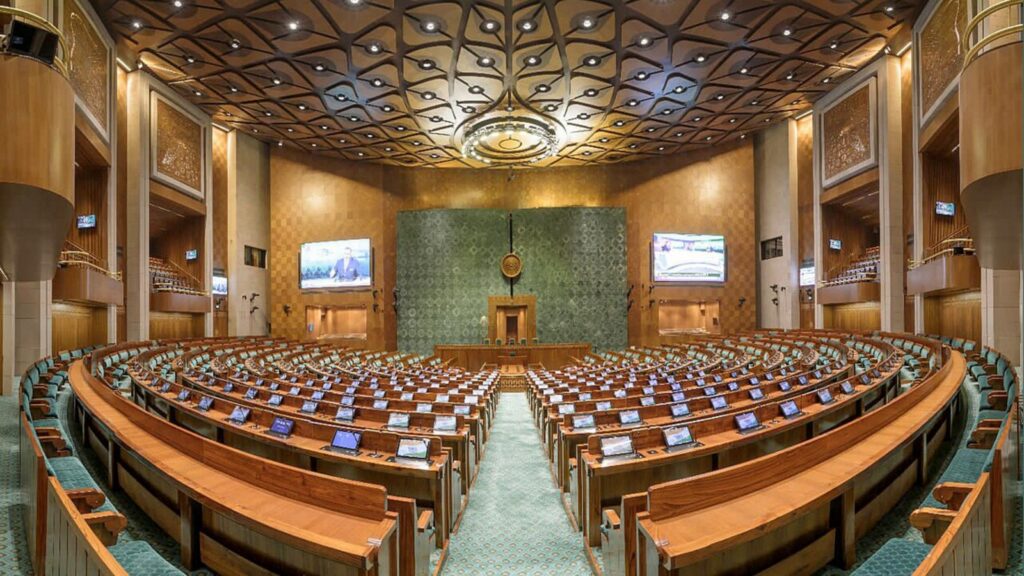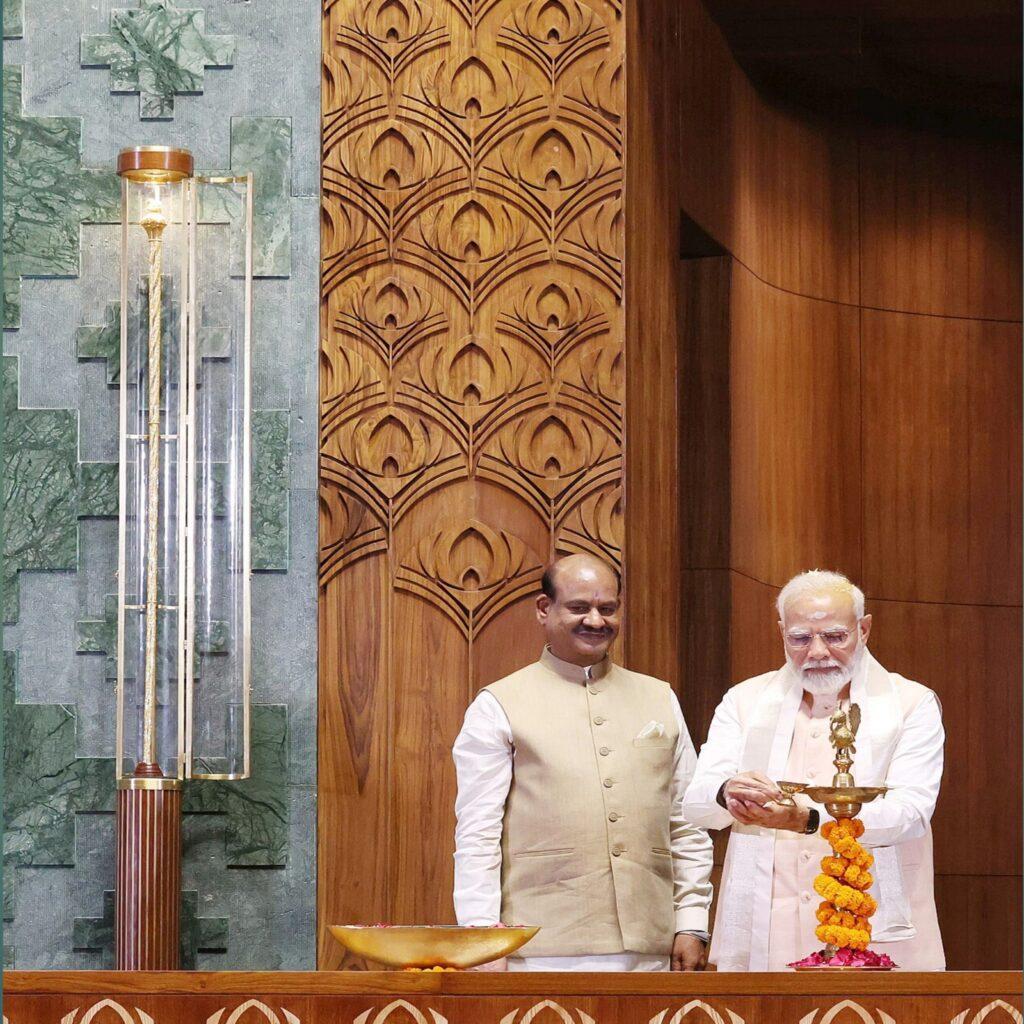New Delhi is home to India’s legislative body, the Parliament of India, which meets in the Parliament House (IAST: Sansad Bhavan). The lower and upper houses of India’s bicameral parliament, the Lok Sabha and Rajya Sabha, meet there.

The new Parliament building in New Delhi was built as part of India’s Central Vista Redevelopment Project. It was officially opened by Prime Minister Narendra Modi on May 28, 2023.
Located on Rafi Marg, which crosses the Central Vista, it is surrounded by the Old Parliament House, Vijay Chowk, India Gate, the National War Memorial, the Vice President’s House, Hyderabad House, the Secretariat Building, the Prime Minister’s Office and residence, ministerial buildings, and other administrative units of the Indian government.
Official proceedings were held for the first time in the New Parliament House, officially known as the Parliament of India, on September 19, 2023, during the Parliament Special Session.
Background
Concerns about the security of the older building led to plans for a new parliament building to replace the one that is there now. In 2012, the Speaker at the time, Meira Kumar, set up a group to come up with different ideas for the building. The original building, which was 93 years old, didn’t have enough room for members of Congress and their staff, and changes to the plan made it less earthquake-proof, which put its stability at risk. Even so, the building is an important part of India’s national history, and there are plans to keep it safe.
Commencement
The Indian government started the Central Vista Redevelopment Project in 2019. This project included building a new parliament building and doing other things in New Delhi, like fixing up Kartavya Path, building a new home for the vice president, building a new office and home for the prime minister, and putting all ministerial buildings into a single central secretariat.
In October 2020, there was a gathering to start building, and on December 10, 2020, Prime Minister Narendra Modi put the first stone in place. At the event, religious leaders led a service of prayers from different faiths.
Even though the foundation stone could be laid, the Central Vista Redevelopment Project was put on hold by a bench of the Supreme Court of India led by Justice A. M. Khanwilkar until the court could decide what to do about the complaints against the project. In January 2021, a majority of the Supreme Court ruled that the project could go forward, with some conditions to protect the environment. Work on the building, then began.
Description
The old parliament building, which was built in 1927, was planned by British architects Sir Edwin Lutyens and Sir Herbert Baker. The Hindu Yogini Temple at Mitaoli had a big impact on the design.
The new complex is built next to the old one and is almost the same size as the old one. It is in the shape of a hexagon.
By chance, this Parliament building looks a lot like the Vijaya Temple of Vidisha.
The building is built to last for more than 150 years. It is made to withstand earthquakes, and types of architecture from different parts of India are used to make it. Both the Lok Sabha and the Rajya Sabha rooms have enough seats for more members than are currently there. This is because India’s population is growing, which could lead to more MPs in the future.

The new building has a room for the Lok Sabha with 888 seats and a room for the Rajya Sabha with 384 seats. It doesn’t have a main hall like the old Parliament House did. In the case of a joint sitting, the Lok Sabha chamber can fit 1,272 members. The rest of the building has four floors with rooms for committees and offices for officials.
The building has a built area of 20,866 square meters (224,600 square feet), which is 10% smaller than the old circular building, which is 22,900 square meters (246,000 square feet) and has a diameter of 170.7 meters (560 feet) and an open-sky area of 6,060 square meters (65,200 square feet) that is split into three sectors.
Gyan Dwar means “gate of knowledge.” Shakti Dwar means “gate of power,” and Karma Dwar means “gate of duty.” Gaja, Ashwa, Garuda, Makar, Shardula, and Hams are the names of the six statues that stand guard at the three gates.
In the central foyer, there is a Foucault pendulum that hangs from the roof. The National Council of Science Museum (NCSM) in Kolkata made this pendulum, which is the biggest of its kind in India. It stands 22 meters tall and weighs 36 kg. The pendulum hangs from a skylight at the top of Constitution Hall. As it turns on its axis, it almost touches the floor. Its position shows how India’s ideas fit in with the vastness of the universe.
In the new building, the Sengol is in the same room as the Lok Sabha.
The gallery Shilp Deergha (crafts gallery) was designed around eight themes: Parv (festival), Swabalamban (self-reliance), Prakriti (nature), Ullas (joy), Gyan (knowledge), Samrasta (harmony), Astha (faith), and Yatra (journey). About 255 pieces of art were made by 400 artists from all over the country.
“All-religion prayer” (Sarva Dharma Prarthana) was done, and religious leaders from Zoroastrianism, the Baha’i Faith, Judaism, Islam, Jainism, Buddhism, Sikhism, and Hinduism were there.
Inauguration

On May 28, 2023, India’s new parliament building was publicly opened by the Prime Minister, Narendra Modi. In the morning, Modi unveiled a plaque that said the building was for the whole country and then spoke to a group of politicians. As part of the opening event, Adheenam priests gave PM Modi a gold-plated scepter called Sengol. This is a Tamil tradition, and PM Modi put it next to the chair of the Speaker of the Lok Sabha in the new Parliament building.
Most of the opposition groups didn’t go to the event because they wanted the president, not the prime minister, to open the building. At the ceremony, religious leaders also led a prayer service called Sarva Dharma, which means “all faiths.”
Boycott and criticism
Although the Congress party in India had called for a boycott of the inauguration, more than 300 members of parliament showed up anyway. To show their displeasure with Modi’s rule, at least 19 opposition parties decided to skip his inauguration. Fear was voiced that President Droupadi Murmu, the country’s highest constitutional authority, was being ignored. In addition to claiming that the administration rushed through contentious legislation without enough debate, the opposition parties also blasted the government’s “disqualification, suspension, and muting” of opposition MPs.
Diplomatic row
A map of an “undivided India” painted on a wall in the new parliament caused a political row with Nepal, Pakistan, and Bangladesh, which are all close by. On May 28, 2023, India’s minister of parliamentary affairs, Pralhad Joshi, posted a picture of a mural with a Kannada sentence that translates to “Resolution is clear—Akhand Bharat.”
On May 30, 2023, the former prime minister of Nepal, KP Sharma Oli, spoke out against the move. He said, “If a country like India, which sees itself as an old, strong, and democratic model, puts Nepali territories on its map and hangs the map in Parliament, it can’t be called fair.” [40] Baburam Bhattarai, the former prime minister of Nepal, also spoke out against “the controversial mural of ‘Akhand Bharat,'” which he said “has the potential to make the trust gap between India and most of its neighbors even worse.”
On June 1, 2023, Pakistan’s Foreign Office spokeswoman, Mumtaz Zahra Baloch, said, “We are horrified that some BJP politicians, including a union minister, have linked the mural to “Akhand Bharat.”
On June 6, 2023, Bangladesh’s Minister of State for Foreign Affairs, Shahriar Alam, said that his country is asking India for more information about the plan.
Dr. S. Jaishankar, India’s foreign minister, said on June 8, 2023, in response to concerns, “The mural of undivided India shows the spread of the Ashoka empire and the idea of responsible and people-oriented governance.” In response to Pakistan’s complaint, he said, “Pakistan can’t understand it because it doesn’t have the ability to understand.” He also said that the mural’s meaning will be clear to the countries around it.
Arindam Bagchi, who was the official spokesperson for India’s Ministry of External Affairs (MEA), had also said before that the painting showed how the Mauryan period spread throughout Indian history.
Timeline
- The Government of India creates the “Redevelopment of Central Vista Avenue” master plan in September of 2019.
- The CPWD awarded the contract to Tata Projects Ltd. in September 2020, and the new parliament building is scheduled for completion in 2022 at a cost of 862 crore.
- HCP Design Planning and Management Pvt. Ltd. of Ahmedabad, India, is awarded the contract for architectural consulting services in October 2020.
- The new parliament building’s cornerstone will be placed on December 10th, 2020.
- On July 11, 2022, a statue representing the country’s insignia will be unveiled atop the new Parliament building.
- The new Parliament’s primary framework is finished on the 28th of August, 2022.
- The project will be finished on May 20, 2023.
- Prime Minister Narendra Modi will open the brand new Parliament Building on May 28th, 2023.
- Starting with the Special Session of Parliament in 2023, House business will resume on September 19.